warning light VOLKSWAGEN UP! 2021 Owner´s Manual
[x] Cancel search | Manufacturer: VOLKSWAGEN, Model Year: 2021, Model line: UP!, Model: VOLKSWAGEN UP! 2021Pages: 211, PDF Size: 5.98 MB
Page 1 of 211

Owner's manual*Owner's manual
Owner's manual
RCD 210, RCD 215
Replacement service schedule
Edition: 11.2012
Item number: 132.5R1.BUP.20
Refers to a section within a chapter that contains important information and safety
notes that should always be observed.
Indicates that the section is continued on the next page.
Indicates the end of a section.
Indicates situations in which the vehicle must be stopped as quickly as possible.
®Indicates a registered trademark. However, the absence of this symbol does not
constitute a waiver of the rights concerning any term.
⇒
Symbols like these refer you to warnings within the same section or on a given
page. They draw your attention to possible risks of accident or injury and explain
how they can be avoided.
⇒Cross reference to information about possible damage to your vehicle within the
same section or on a given page.
Texts with this symbol contain additional information on the protection of the environment.
Texts with this symbol contain additional information.
Thank you for choosing Volkswagen
By purchasing this Volkswagen, you have become the owner of a vehicle fitted with the most up-to-
date technology and a multitude of convenience functions for your use and enjoyment.
Before using your vehicle for the first time, please read and observe the information in this
owner's manual. It will quickly help you to become familiar with your vehicle and all of its
functions as well as making you aware of dangers to yourself and others and of how these
dangers can be avoided.
If you have any further questions about your vehicle, or if you think that the vehicle wallet has not
covered everything, please get in touch with your Volkswagen dealership. They will always be
happy to deal with your questions, suggestions or problems.
up!
Description of symbols
Texts with this symbol indicate dangerous situations which will lead to fatal or severe injuries
if you do not observe the warning.
DANGER
Texts with this symbol indicate dangerous situations which could lead to fatal or severe
injuries if you do not observe the warning.
WARNING
Texts with this symbol indicate dangerous situations which could lead to slight or severe
injuries if you do not observe the warning.
CAUTION
Texts with this symbol indicate situations which could cause vehicle damage if you do not
observe the warning.
NOTICE
Description of symbols
Thank you for choosing Volkswagen
About this owner's manual
Overview of the vehicle
Before the journey
While driving
Cleaning and maintenance
If and when
Abbreviations
Index
Epilog
Page 5 of 211
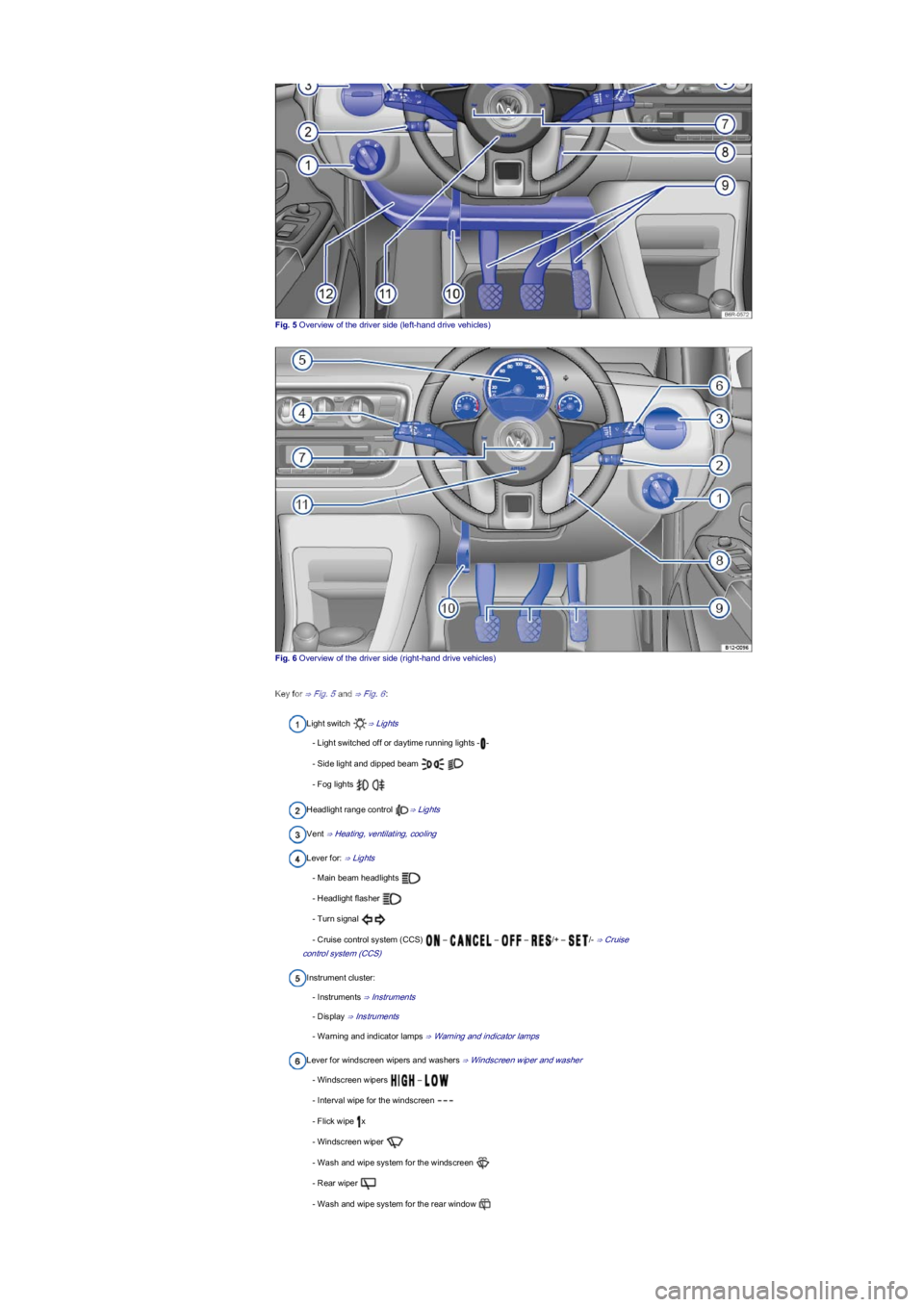
Fig. 5 Overview of the driver side (left-hand drive vehicles)
Fig. 6 Overview of the driver side (right-hand drive vehicles)
Key for ⇒ Fig. 5 and ⇒ Fig. 6:
Light switch ⇒ Lights
- Light switched off or daytime running lights --
- Side light and dipped beam
- Fog lights
Headlight range control ⇒ Lights
Vent ⇒ Heating, ventilating, cooling
Lever for: ⇒ Lights
- Main beam headlights
- Headlight flasher
- Turn signal
- Cruise control system (CCS) – – – /+ – /- ⇒ Cruise
control system (CCS)
Instrument cluster:
- Instruments ⇒ Instruments
- Display ⇒ Instruments
- Warning and indicator lamps ⇒ Warning and indicator lamps
Lever for windscreen wipers and washers ⇒ Windscreen wiper and washer
- Windscreen wipers –
- Interval wipe for the windscreen
- Flick wipe x
- Windscreen wiper
- Wash and wipe system for the windscreen
- Rear wiper
- Wash and wipe system for the rear window
Page 6 of 211
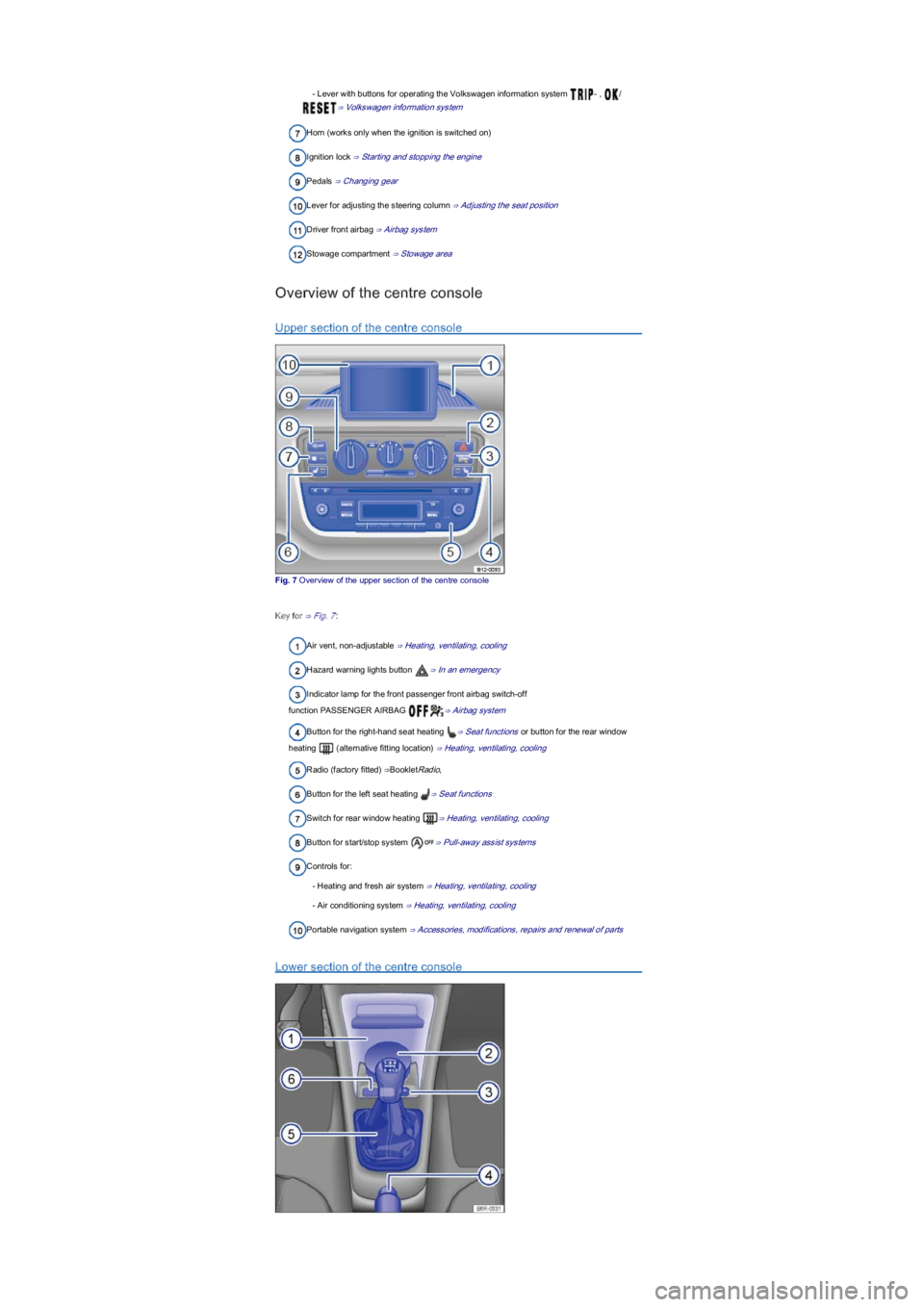
- Lever with buttons for operating the Volkswagen information system - , /
⇒ Volkswagen information system
Horn (works only when the ignition is switched on)
Ignition lock ⇒ Starting and stopping the engine
Pedals ⇒ Changing gear
Lever for adjusting the steering column ⇒ Adjusting the seat position
Driver front airbag ⇒ Airbag system
Stowage compartment ⇒ Stowage area
Overview of the centre console
Upper section of the centre console
Fig. 7 Overview of the upper section of the centre console
Key for ⇒ Fig. 7:
Air vent, non-adjustable ⇒ Heating, ventilating, cooling
Hazard warning lights button ⇒ In an emergency
Indicator lamp for the front passenger front airbag switch-off
function PASSENGER AIRBAG ⇒ Airbag system
Button for the right-hand seat heating ⇒ Seat functions or button for the rear window
heating (alternative fitting location) ⇒ Heating, ventilating, cooling
Radio (factory fitted) ⇒BookletRadio,
Button for the left seat heating ⇒ Seat functions
Switch for rear window heating ⇒ Heating, ventilating, cooling
Button for start/stop system ⇒ Pull-away assist systems
Controls for:
- Heating and fresh air system ⇒ Heating, ventilating, cooling
- Air conditioning system ⇒ Heating, ventilating, cooling
Portable navigation system ⇒ Accessories, modifications, repairs and renewal of parts
Lower section of the centre console
Page 7 of 211
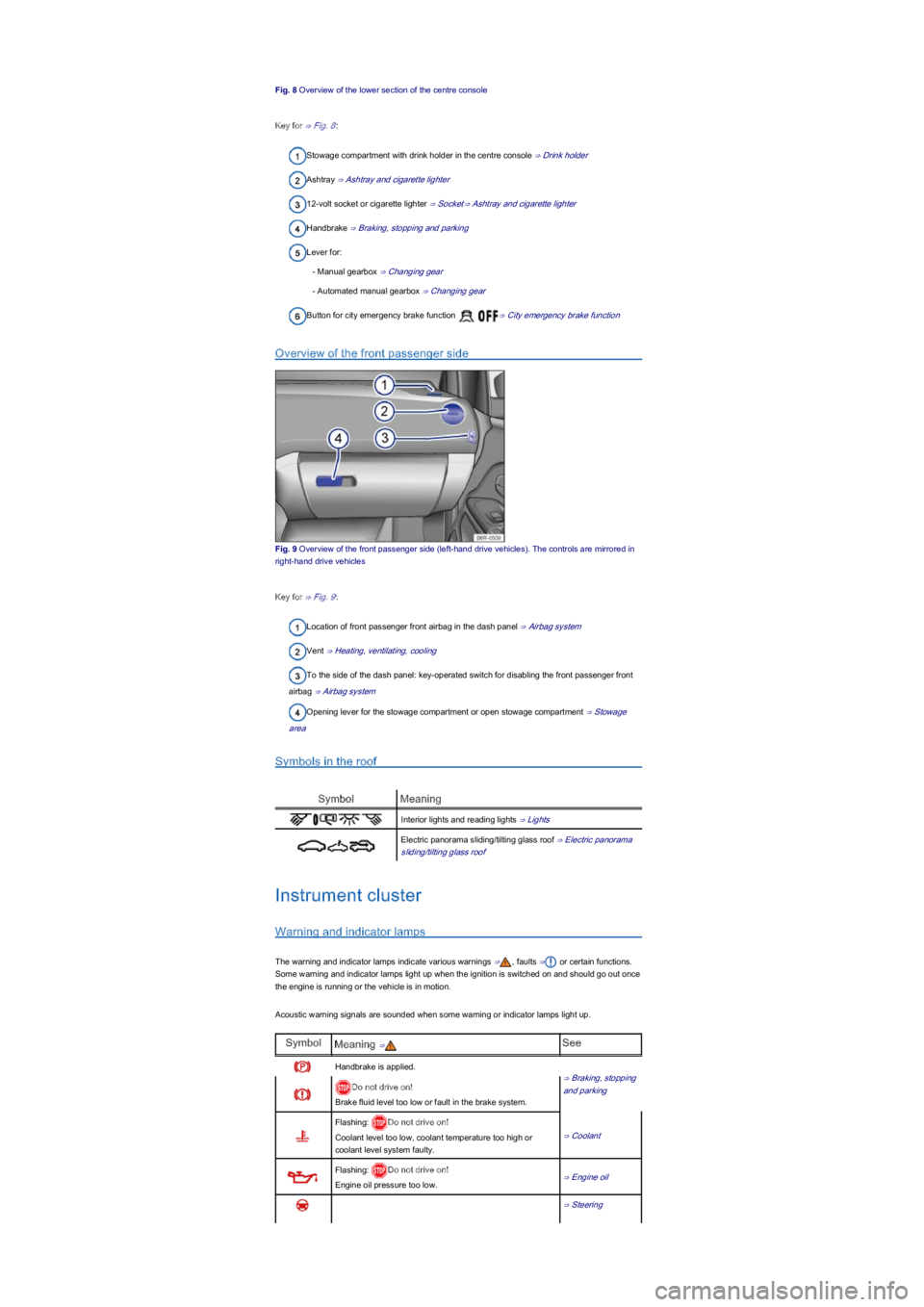
Fig. 8 Overview of the lower section of the centre console
Key for ⇒ Fig. 8:
Stowage compartment with drink holder in the centre console ⇒ Drink holder
Ashtray ⇒ Ashtray and cigarette lighter
12-volt socket or cigarette lighter ⇒ Socket⇒ Ashtray and cigarette lighter
Handbrake ⇒ Braking, stopping and parking
Lever for:
- Manual gearbox ⇒ Changing gear
- Automated manual gearbox ⇒ Changing gear
Button for city emergency brake function ⇒ City emergency brake function
Overview of the front passenger side
Fig. 9 Overview of the front passenger side (left-hand drive vehicles). The controls are mirrored in
right-hand drive vehicles
Key for ⇒ Fig. 9:
Location of front passenger front airbag in the dash panel ⇒ Airbag system
Vent ⇒ Heating, ventilating, cooling
To the side of the dash panel: key-operated switch for disabling the front passenger front
airbag ⇒ Airbag system
Opening lever for the stowage compartment or open stowage compartment ⇒ Stowage
area
Symbols in the roof
SymbolMeaning
Interior lights and reading lights ⇒ Lights
Electric panorama sliding/tilting glass roof ⇒ Electric panorama
sliding/tilting glass roof
Instrument cluster
Warning and indicator lamps
The warning and indicator lamps indicate various warnings ⇒, faults ⇒ or certain functions.
Some warning and indicator lamps light up when the ignition is switched on and should go out once
the engine is running or the vehicle is in motion.
Acoustic warning signals are sounded when some warning or indicator lamps light up.
SymbolMeaning ⇒See
Handbrake is applied.
⇒ Braking, stopping
and parkingDo not drive on!
Brake fluid level too low or fault in the brake system.
Flashing: Do not drive on!
Coolant level too low, coolant temperature too high or
coolant level system faulty.
⇒ Coolant
Flashing: Do not drive on!
Engine oil pressure too low.⇒ Engine oil
⇒ Steering
Page 8 of 211

SymbolMeaning ⇒See
Do not drive on!
The electromechanical steering is faulty or not working.
Driver or front passenger seat belt not fastened.
⇒ Seat belts
There are objects on the front passenger seat.
Fault in the alternator.⇒ Vehicle battery
Vehicles with start/stop system: manual engine start
required.
⇒ Pull-away assist
systems
Fault in the automated manual gearbox.⇒ Changing gear
Lit up: there is a fault in the ESC, or it has been switched of
for system-related reasons
OR: together with the ABS indicator lamp : ABS fault.
OR: the vehicle battery has been reconnected.
⇒ Braking, stopping
and parking
Flashing: ESC/TCS is taking corrective action.
Lit up: Traction Control fault or switched off for system-
related reasons.
Flashes: Traction Control active.
ABS faulty or not functioning.
The rear fog light is switched on.⇒ Lights
Lit up or flashing: catalytic converter fault.⇒ Engine
management
system and exhaust
purification system
Engine management system fault (Electronic Power
Control).
Electromechanical steering function reduced.⇒ Steering
Petrol tank nearly empty.⇒ Filling the tank
Natural gas tank nearly empty.⇒ Filling the tank
Fault in airbag and belt tensioner system.⇒ Airbag system
Automated manual gearbox overheated, or the gears
cannot be selected correctly.⇒ Changing gear
Flashing: vehicle with an automated manual gearbox is not
secured from rolling away.
Changing gear
⇒ Changing gear
Braking, stopping
and parking
⇒ Braking, stopping
and parking
Turn signal left or right.⇒ Lights
Hazard warning lights switched on.⇒ In an emergency
Cruise control system is controlling the speed.⇒ Cruise control
system (CCS)
Depress the brake pedal.
Changing gear
⇒ Changing gear
Braking, stopping
and parking
⇒ Braking, stopping
and parking
Main beam is switched on or the headlight flasher is being
operated.⇒ Lights
Engine coolant temperature is too low in vehicles with
natural gas engine.⇒ Coolant
Seat belt fastened for a rear seat passenger.
⇒ Seat belts
Seat belt not fastened for a rear seat passenger.
Immobilizer active.⇒ Starting and
stopping the engine
After switching on the ignition: Display to indicate that a
service is due soon.
⇒ Instruments
Black ice warning. The outside temperature is below
+4°C (+39°F).
Flashing quickly: City emergency brake function braking
automatically or has braked automatically.
⇒ City emergency
brake function
Flashing slowly: City emergency brake function currently
not available.
City emergency brake function has been switched on
manually. Switches off after approx. 5 seconds.
City emergency brake function has been switched off
manually.
Lit up: start/stop system is available.
Flashing: start/stop system is not available.⇒ Pull-away assist
systemsStart/stop system is available, but an automatic engine stop
is not possible.
Page 9 of 211
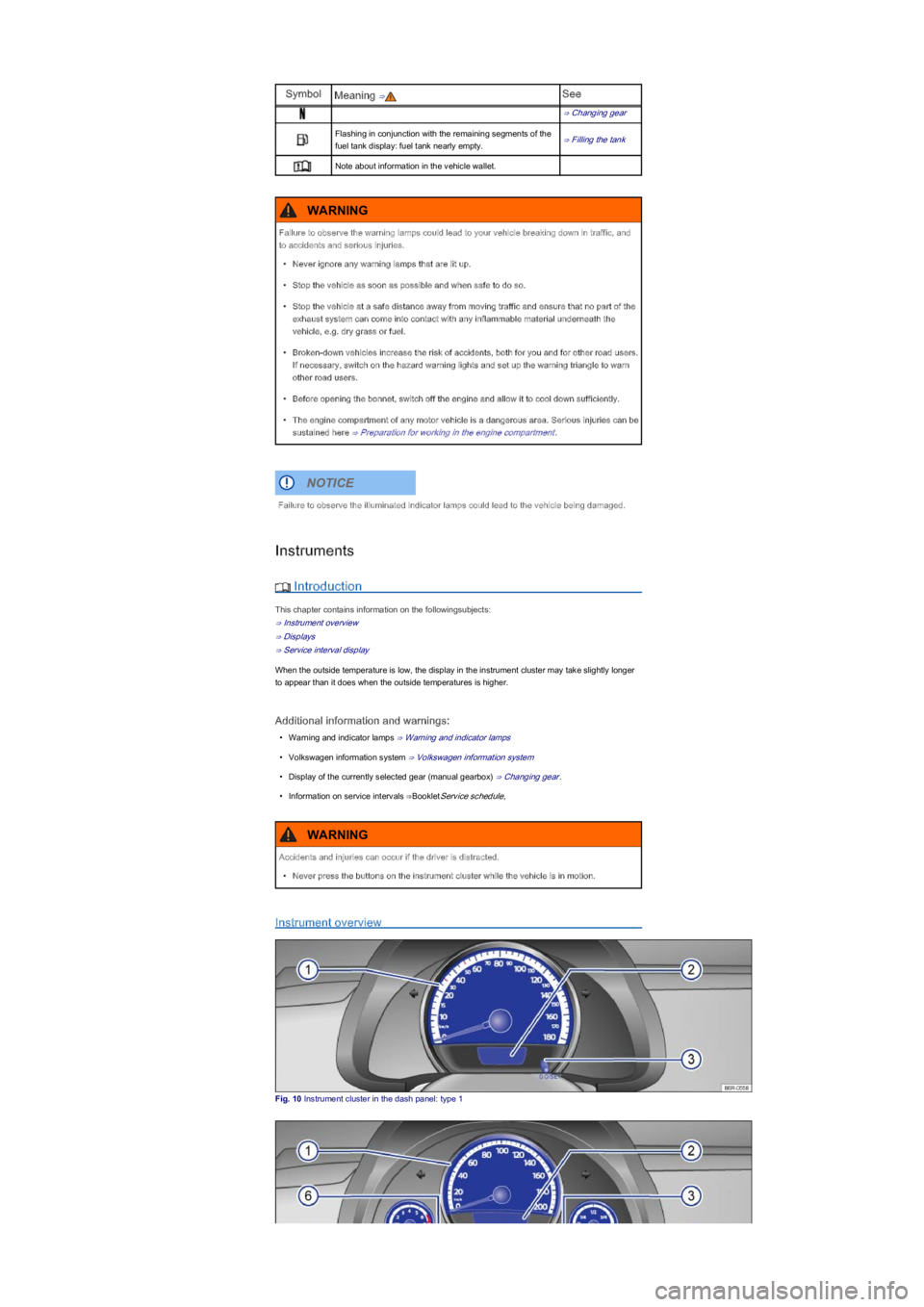
SymbolMeaning ⇒See
⇒ Changing gear
Flashing in conjunction with the remaining segments of the
fuel tank display: fuel tank nearly empty.⇒ Filling the tank
Note about information in the vehicle wallet.
Instruments
Introduction
This chapter contains information on the followingsubjects:
⇒ Instrument overview
⇒ Displays
⇒ Service interval display
When the outside temperature is low, the display in the instrument cluster may take slightly longer
to appear than it does when the outside temperatures is higher.
Additional information and warnings:
•Warning and indicator lamps ⇒ Warning and indicator lamps
•Volkswagen information system ⇒ Volkswagen information system
•Display of the currently selected gear (manual gearbox) ⇒ Changing gear.
•Information on service intervals ⇒BookletService schedule,
Instrument overview
Fig. 10 Instrument cluster in the dash panel: type 1
Failure to observe the warning lamps could lead to your vehicle breaking down in traffic, and
to accidents and serious injuries.
•Never ignore any warning lamps that are lit up.
•Stop the vehicle as soon as possible and when safe to do so.
•Stop the vehicle at a safe distance away from moving traffic and ensure that no part of the
exhaust system can come into contact with any inflammable material underneath the
vehicle, e.g. dry grass or fuel.
•Broken-down vehicles increase the risk of accidents, both for you and for other road users.
If necessary, switch on the hazard warning lights and set up the warning triangle to warn
other road users.
•Before opening the bonnet, switch off the engine and allow it to cool down sufficiently.
•The engine compartment of any motor vehicle is a dangerous area. Serious injuries can be
sustained here ⇒ Preparation for working in the engine compartment.
WARNING
Failure to observe the illuminated indicator lamps could lead to the vehicle being damaged.
NOTICE
Accidents and injuries can occur if the driver is distracted.
•Never press the buttons on the instrument cluster while the vehicle is in motion.
WARNING
Page 10 of 211

Fig. 11 Instrument cluster in the dash panel: type 2
First read and observe the introductoryinformation and safety warnings⇒
Introduction
Depending on the equipment level, the scale divisions may look slightly different in type 2 ⇒ Fig. 11
.
Descriptions of the instruments ⇒ Fig. 10 or ⇒ Fig. 11:
Speedometer in km/h or in mph and km/h, depending on vehicle.
Displays⇒ Displays.
Reset button for the trip recorder display (trip).
- Press the button briefly to switch between the trip recorder and the
odometer.
- Press the button for about 5 seconds to reset the trip recorder and any
other indicators in the multifunction display ⇒ Volkswagen information system.
Fuel gauge⇒ Filling the tank.
Rev counter (running engine speed in revolutions x 1,000 per minute).The start of the red
zone on the dial indicates the maximum engine speed that may be used in each gear when the
engine is warm and after it has been run in properly. It is advisable to change up a gear or lift
your foot off the accelerator before the needle reaches the red zone ⇒.
Setting button for the clock or for switching between outside temperature display and
clock.
- To set the clock, select the time display if not already selected. To do this, push the
rocker switch ⇒ Fig. 12② up or down, or press setting button ⇒ Fig. 11⑥.
- Press and hold the button to mark the hour display so that it flashes.
- Press the button to continue. Press and hold to scroll through quickly.
- Press the button again briefly to select the minute display so that it flashes.
- Press the button to continue. Press and hold to scroll through quickly.
- Press the button again to finish setting the clock.
Changing up a gear early will help to save fuel and minimise engine noise.
Other instruments, such as the outside temperature display, can be shown in the screen of
the portable navigation device (delivered by Volkswagen) ⇒ Accessories, modifications, repairs and
renewal of parts.
Displays
First read and observe the introductoryinformation and safety warnings⇒
Introduction
Depending on the vehicle equipment level, a variety of information can be displayed in the
instrument cluster ⇒ Fig. 10② or ⇒ Fig. 11②:
•Warning and information displays
•Distance displays
•Time
•Outside temperature
•Selector lever positions ⇒ Changing gear
•Gear-change indicator (manual gearbox) ⇒ Changing gear
•Multifunction display (MFD) ⇒ Volkswagen information system
•Service interval display ⇒ Service interval display
•Start/stop system status display ⇒ Pull-away assist systems
•Fuel gauge ⇒ Filling the tank
•Belt status display for the rear seats ⇒ Seat belts
•When the engine is cold, avoid high engine speeds, driving at full throttle and over-loading
the engine.
•The needle on the rev counter should only briefly tip into the red area. Damage to the
engine may otherwise be incurred.
NOTICE
Page 11 of 211
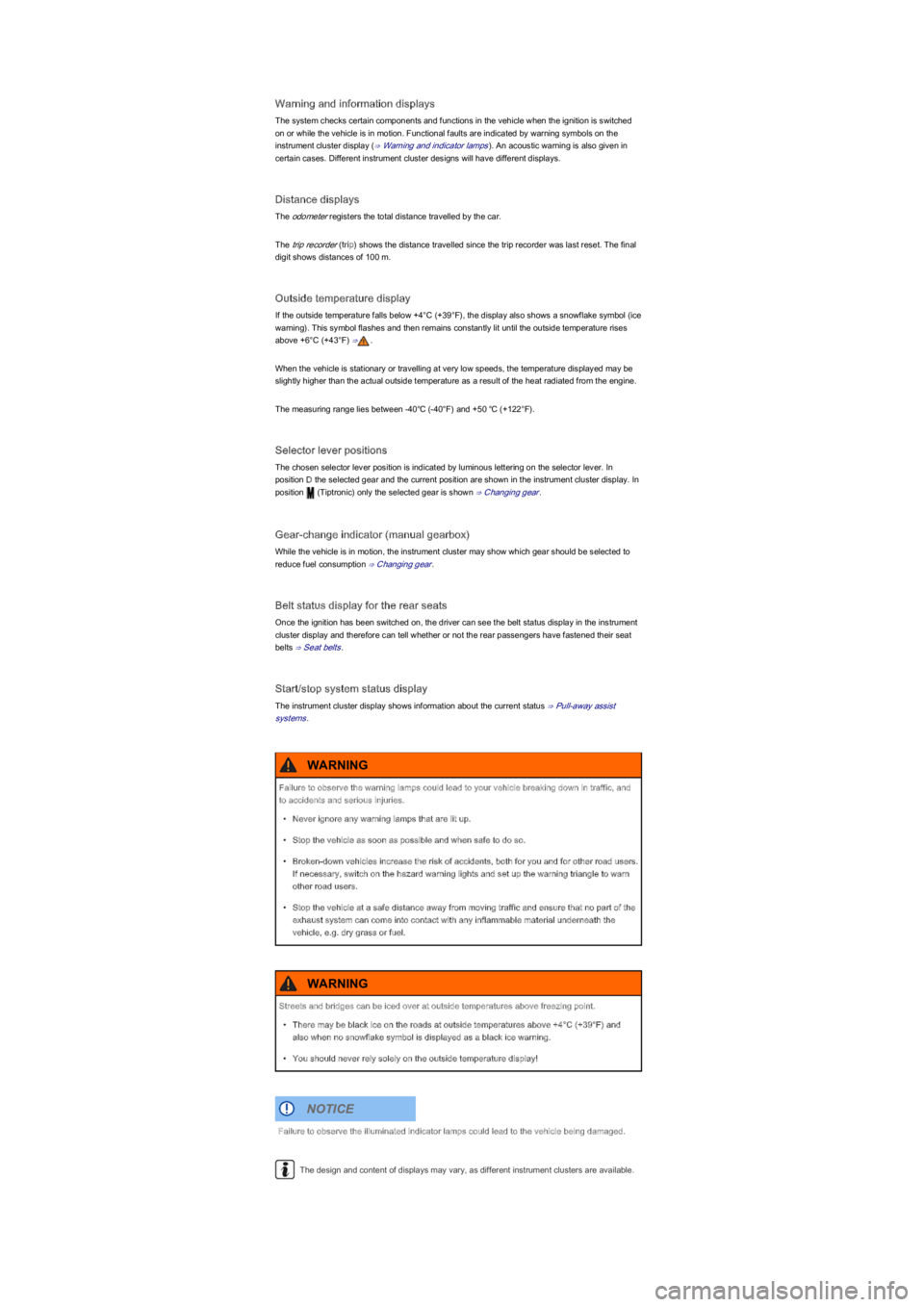
Warning and information displays
The system checks certain components and functions in the vehicle when the ignition is switched
on or while the vehicle is in motion. Functional faults are indicated by warning symbols on the
instrument cluster display (⇒ Warning and indicator lamps). An acoustic warning is also given in
certain cases. Different instrument cluster designs will have different displays.
Distance displays
The odometer registers the total distance travelled by the car.
The trip recorder (trip) shows the distance travelled since the trip recorder was last reset. The final
digit shows distances of 100 m.
Outside temperature display
If the outside temperature falls below +4°C (+39°F), the display also shows a snowflake symbol (ice
warning). This symbol flashes and then remains constantly lit until the outside temperature rises
above +6°C (+43°F) ⇒.
When the vehicle is stationary or travelling at very low speeds, the temperature displayed may be
slightly higher than the actual outside temperature as a result of the heat radiated from the engine.
The measuring range lies between -40℃ (-40°F) and +50 ℃ (+122°F).
Selector lever positions
The chosen selector lever position is indicated by luminous lettering on the selector lever. In
position D the selected gear and the current position are shown in the instrument cluster display. In
position (Tiptronic) only the selected gear is shown ⇒ Changing gear.
Gear-change indicator (manual gearbox)
While the vehicle is in motion, the instrument cluster may show which gear should be selected to
reduce fuel consumption ⇒ Changing gear.
Belt status display for the rear seats
Once the ignition has been switched on, the driver can see the belt status display in the instrument
cluster display and therefore can tell whether or not the rear passengers have fastened their seat
belts ⇒ Seat belts.
Start/stop system status display
The instrument cluster display shows information about the current status ⇒ Pull-away assist
systems.
The design and content of displays may vary, as different instrument clusters are available.
Failure to observe the warning lamps could lead to your vehicle breaking down in traffic, and
to accidents and serious injuries.
•Never ignore any warning lamps that are lit up.
•Stop the vehicle as soon as possible and when safe to do so.
•Broken-down vehicles increase the risk of accidents, both for you and for other road users.
If necessary, switch on the hazard warning lights and set up the warning triangle to warn
other road users.
•Stop the vehicle at a safe distance away from moving traffic and ensure that no part of the
exhaust system can come into contact with any inflammable material underneath the
vehicle, e.g. dry grass or fuel.
WARNING
Streets and bridges can be iced over at outside temperatures above freezing point.
•There may be black ice on the roads at outside temperatures above +4°C (+39°F) and
also when no snowflake symbol is displayed as a black ice warning.
•You should never rely solely on the outside temperature display!
WARNING
Failure to observe the illuminated indicator lamps could lead to the vehicle being damaged.
NOTICE
Page 14 of 211
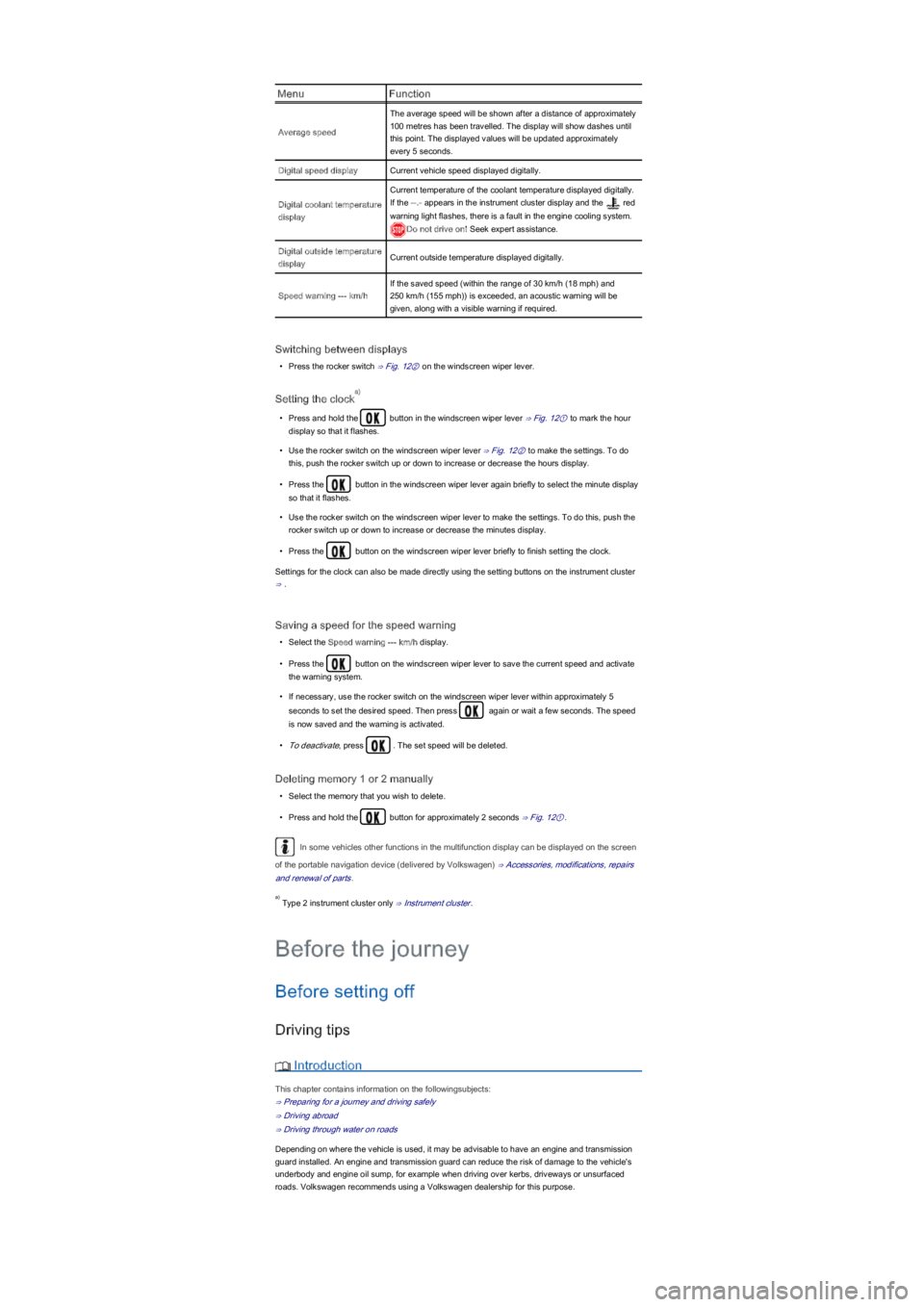
MenuFunction
Average speed
The average speed will be shown after a distance of approximately
100 metres has been travelled. The display will show dashes until
this point. The displayed values will be updated approximately
every 5 seconds.
Digital speed displayCurrent vehicle speed displayed digitally.
Digital coolant temperature
display
Current temperature of the coolant temperature displayed digitally.
If the --.- appears in the instrument cluster display and the red
warning light flashes, there is a fault in the engine cooling system.
Do not drive on! Seek expert assistance.
Digital outside temperature
displayCurrent outside temperature displayed digitally.
Speed warning --- km/h
If the saved speed (within the range of 30 km/h (18 mph) and
250 km/h (155 mph)) is exceeded, an acoustic warning will be
given, along with a visible warning if required.
Switching between displays
•Press the rocker switch ⇒ Fig. 12② on the windscreen wiper lever.
Setting the clock
•Press and hold the button in the windscreen wiper lever ⇒ Fig. 12① to mark the hour
display so that it flashes.
•Use the rocker switch on the windscreen wiper lever ⇒ Fig. 12② to make the settings. To do
this, push the rocker switch up or down to increase or decrease the hours display.
•Press the button in the windscreen wiper lever again briefly to select the minute display
so that it flashes.
•Use the rocker switch on the windscreen wiper lever to make the settings. To do this, push the
rocker switch up or down to increase or decrease the minutes display.
•Press the button on the windscreen wiper lever briefly to finish setting the clock.
Settings for the clock can also be made directly using the setting buttons on the instrument cluster
⇒ .
Saving a speed for the speed warning
•Select the Speed warning --- km/h display.
•Press the button on the windscreen wiper lever to save the current speed and activate
the warning system.
•If necessary, use the rocker switch on the windscreen wiper lever within approximately 5
seconds to set the desired speed. Then press again or wait a few seconds. The speed
is now saved and the warning is activated.
•To deactivate, press . The set speed will be deleted.
Deleting memory 1 or 2 manually
•Select the memory that you wish to delete.
•Press and hold the button for approximately 2 seconds ⇒ Fig. 12①.
In some vehicles other functions in the multifunction display can be displayed on the screen
of the portable navigation device (delivered by Volkswagen) ⇒ Accessories, modifications, repairs
and renewal of parts.
Type 2 instrument cluster only ⇒ Instrument cluster.
Before setting off
Driving tips
Introduction
This chapter contains information on the followingsubjects:
⇒ Preparing for a journey and driving safely
⇒ Driving abroad
⇒ Driving through water on roads
Depending on where the vehicle is used, it may be advisable to have an engine and transmission
guard installed. An engine and transmission guard can reduce the risk of damage to the vehicle's
underbody and engine oil sump, for example when driving over kerbs, driveways or unsurfaced
roads. Volkswagen recommends using a Volkswagen dealership for this purpose.
a)
a)
Before the journey
Page 15 of 211
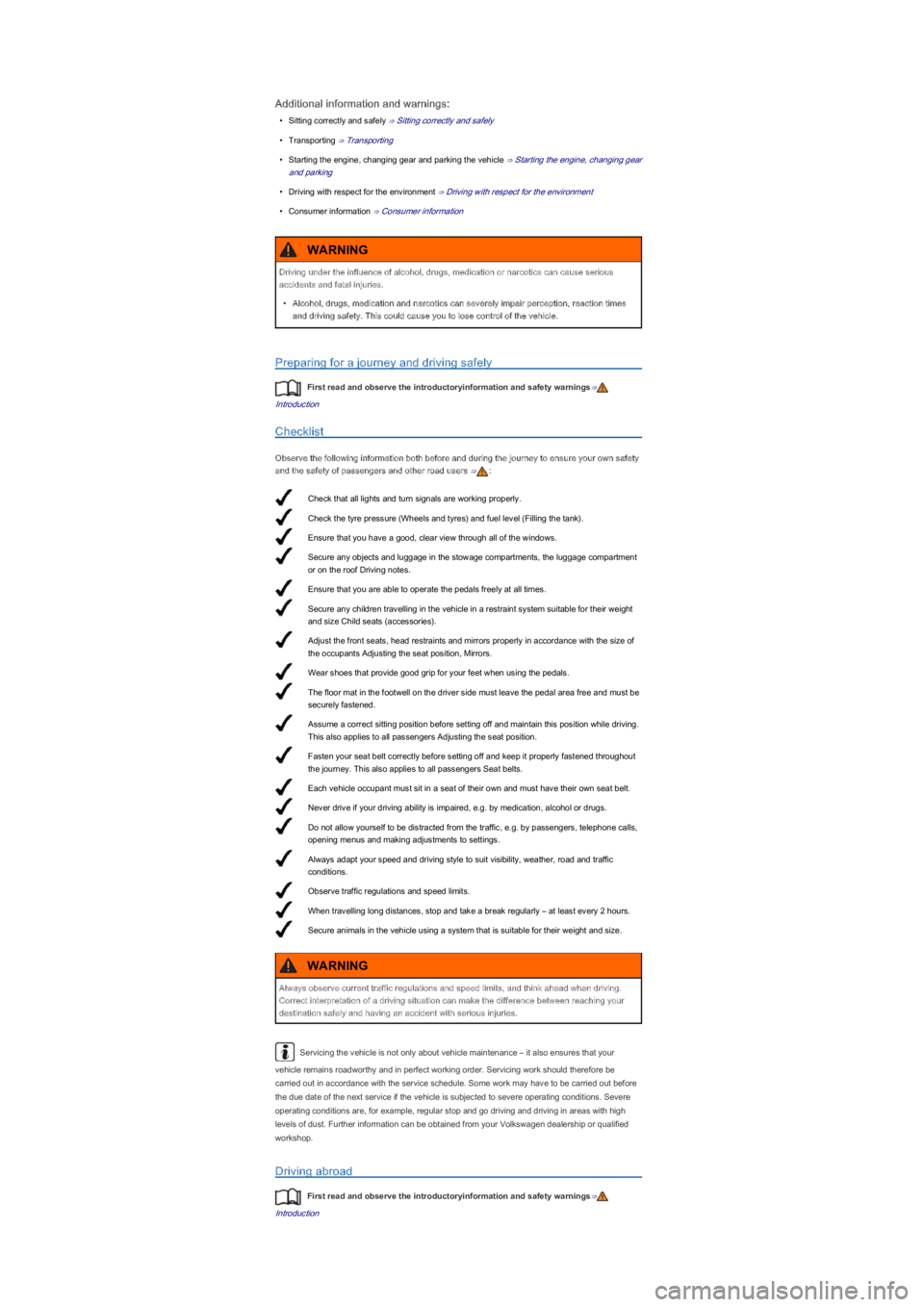
Check that all lights and turn signals are working properly.
Check the tyre pressure (Wheels and tyres) and fuel level (Filling the tank).
Ensure that you have a good, clear view through all of the windows.
Secure any objects and luggage in the stowage compartments, the luggage compartment
or on the roof Driving notes.
Ensure that you are able to operate the pedals freely at all times.
Secure any children travelling in the vehicle in a restraint system suitable for their weight
and size Child seats (accessories).
Adjust the front seats, head restraints and mirrors properly in accordance with the size of
the occupants Adjusting the seat position, Mirrors.
Wear shoes that provide good grip for your feet when using the pedals.
The floor mat in the footwell on the driver side must leave the pedal area free and must be
securely fastened.
Assume a correct sitting position before setting off and maintain this position while driving.
This also applies to all passengers Adjusting the seat position.
Fasten your seat belt correctly before setting off and keep it properly fastened throughout
the journey. This also applies to all passengers Seat belts.
Each vehicle occupant must sit in a seat of their own and must have their own seat belt.
Never drive if your driving ability is impaired, e.g. by medication, alcohol or drugs.
Do not allow yourself to be distracted from the traffic, e.g. by passengers, telephone calls,
opening menus and making adjustments to settings.
Always adapt your speed and driving style to suit visibility, weather, road and traffic
conditions.
Observe traffic regulations and speed limits.
When travelling long distances, stop and take a break regularly – at least every 2 hours.
Secure animals in the vehicle using a system that is suitable for their weight and size.
Additional information and warnings:
•Sitting correctly and safely ⇒ Sitting correctly and safely
•Transporting ⇒ Transporting
•Starting the engine, changing gear and parking the vehicle ⇒ Starting the engine, changing gear
and parking
•Driving with respect for the environment ⇒ Driving with respect for the environment
•Consumer information ⇒ Consumer information
Preparing for a journey and driving safely
First read and observe the introductoryinformation and safety warnings⇒
Introduction
Checklist
Observe the following information both before and during the journey to ensure your own safety
and the safety of passengers and other road users ⇒:
Servicing the vehicle is not only about vehicle maintenance – it also ensures that your
vehicle remains roadworthy and in perfect working order. Servicing work should therefore be
carried out in accordance with the service schedule. Some work may have to be carried out before
the due date of the next service if the vehicle is subjected to severe operating conditions. Severe
operating conditions are, for example, regular stop and go driving and driving in areas with high
levels of dust. Further information can be obtained from your Volkswagen dealership or qualified
workshop.
Driving abroad
First read and observe the introductoryinformation and safety warnings⇒
Introduction
Driving under the influence of alcohol, drugs, medication or narcotics can cause serious
accidents and fatal injuries.
•Alcohol, drugs, medication and narcotics can severely impair perception, reaction times
and driving safety. This could cause you to lose control of the vehicle.
WARNING
Always observe current traffic regulations and speed limits, and think ahead when driving.
Correct interpretation of a driving situation can make the difference between reaching your
destination safely and having an accident with serious injuries.
WARNING